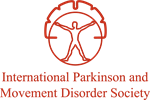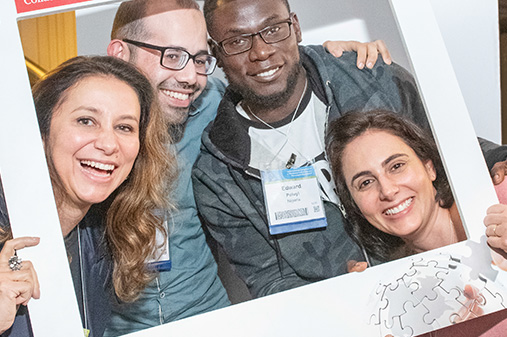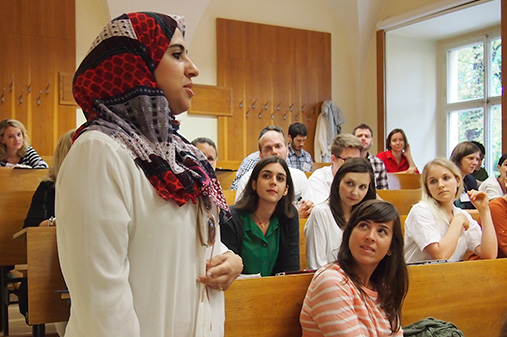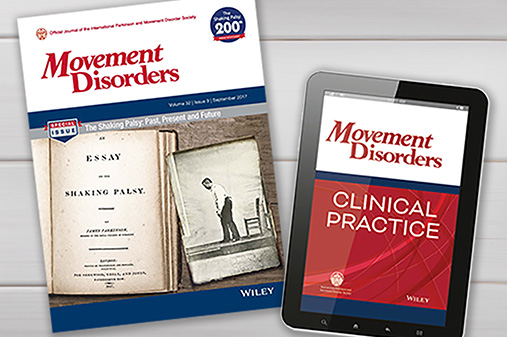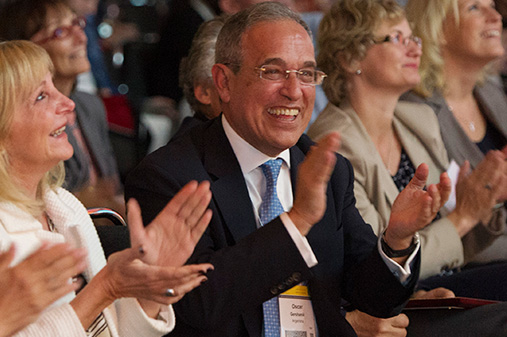The longest prospective study of pallidal DBS for isolated dystonia
Journal CME is available until June 19, 2026
Read the article.
Dr. Mitra Afshari: Hello and welcome to the MDS Podcast, the official podcast of the International Parkinson and Movement Disorder Society. My name is Mitra Afshari. I'm an associate editor of the MDS Podcast series and a movement disorder neurologist and DBS specialist Chicago, Illinois, in the United States. And today we're very excited to have Dr. Patricia Krause and Andrea Kühn with us from Charité Hospital in Berlin, Germany. Patricia and Andrea are the first author and the senior author respectively of the research article will be discussing today. Long-term outcomes of pallidal neurostimulation for dystonia, a controlled perspective, 10 year follow-up.
This was published in the June, 2025 Issue of Movement Disorders. So welcome, Patricia and Andrea. Thank you both for taking the time join us today to discuss to discuss this very important contribution to the DBS literature.
Dr. Patricia Krause: Thank you very much.
View full transcript
Prof. Andrea Kühn: Thank you .
Dr. Mitra Afshari: So in this article, the authors present the findings from a 10 year follow-up study of globus pallidus interna, GPi-DBS in treatment refractory isolated dystonia, patients that were implanted across 10 centers in Australia, Norway, and Germany. The original parent trial enrolled 40 patients, aged 14 to 75, and followed them prospectively.
And this extension study, the authors were able to specifically look at the motor and disability outcomes of 31 of those 40 original patients, and also take a broader look at DBS non-responders and the safety profiles over time. And so all in all, the goal of this work is to provide more evidence for the question. What is the durability [00:02:00] of DBS for dystonia, specifically isolated, generalized, and isolated segmental dystonia and how safe is it long term? So to set the sage, Patricia, I think our audience is familiar with the phenomenology of dystonia, but could you briefly review the definitions of isolated generalized dystonia and isolated segmental dystonia?
And give us kind of a review of how those two patient populations tend to differ.
Dr. Patricia Krause: Yes. I'd like to, so when you talk about isolated dystonia in general, this is a movement disorder that is characterized by involuntary muscle contractions of body parts or the whole body. And this is the difference between the two forms of generalized or segmental dystonia. So you have muscle contractions of the whole body in generalized dystonia or adjacent neighboring body parts in segmental dystonia.
And you may also have tremor, but no [00:03:00] additional other feature in dystonia. And it relies on the clinical presentation and exclusion of other underlying disorders to define dystonia and isolated dystonia.
Dr. Mitra Afshari: And when it comes to generalized dystonia patients versus segmental dystonia patients, do the ages of these patients tend to differ? Do they present at different times?
Dr. Patricia Krause: Absolutely. So generalized dystonia usually starts in the childhood. Very often children start to have difficulties walking limping. And then dystonia is spreading over the body. Patients start to, to develop symptoms already at the age of 4, 5, 6. And segmental or even focal dystonia tend to appear later in the stage of development more often around the end of twenties, thirties, forties.
Dr. Mitra Afshari: Right? So in general, generalized dystonia can be more of a child onset, [00:04:00] segmental more of an adult onset.
Patricia, some of, while some of our listeners are familiar with these statistics that we quote in terms of kind of the general percentage improvement one sees in dystonia following GPi-DBS. Some of our listeners may not be. Can you remind us what previous meta-analysis have shown in terms of the motoric benefit of pallidal stimulation in the short term, like six months to a year?
And also the data that we had previous to this study in the long term, beyond a year. Can you remind us of that information?
Dr. Patricia Krause: So in dystonia it's always a bit difficult to just to really foresee individual benefits of the brain simulation. And this is something that we were able to show that we can achieve up to 56- 70% of improvement with pallidal brain stimulation in dystonia. But it is really depending [00:05:00] on some factors is there a genetic background which might help to respond to DBS?
How long do you have dystonia? Is there already f ixed or more mobile dystonia features. And so it depends. There is as our work shows proof that it's a very long lasting and enduring treatment for patients for dystonia, but there are mixed results.
Dr. Mitra Afshari: Thank you for that. The jumping right into your study and the motor outcome. So your analysis was able to show that from baseline to 10 years, there was about a 56% improvement in dystonia motor scores for both types of dystonia, for the generalized dystonia patients and for the segmental dystonia patients.
And this was measured by the Burke‐Fahn‐Marsden dystonia scale and this improvement was unchanged from what was seen at six months and at five, eight years, again indicating that the benefit was [00:06:00] sustained over 10 years. And similarly, you were also able to show sustained benefit over 10 years when you looked at two other patient reported variables or scales of dystonia severity, the Burke‐Fahn‐Marsden disability score, and a simple visual analog scale of dystonia severity. And then when you separated out the two, patient populations the generalized versus the segmental dystonia patients, the improvement seen was similar.
So Dr. Kühn, Andrea, what do these findings mean to you, and how do these findings translate into your clinical practice? And not only, who you consider as DBS candidates but also how this translate into how you counsel patients who are considering DBS?
Prof. Andrea Kühn: Sure. It's very important and as we pointed out at the beginning generalized dystonia occurs also at already in childhood. It is the long term outcomes really important for these [00:07:00] children because it depends on how well they can attend school and have their independent life. So it's not about five years or even, not about 10 years, but much longer time span that we have to look at.
And so it's very promising that we could show in this study that after 10 years we. Have still a significant effect of pallidal stimulation and there's no significant recurrence of symptoms. So when we counsel our patients, especially also the parents of these children, we can tell them already now that the long term outcome is very positive for pallidal stimulation.
Dr. Mitra Afshari: And also I think we were alluding to this before, the classic teaching is that younger patients with kind of more distal distribution of dystonia respond the best to GPi-DBS compared t o older patients who may have more of the axial or [00:08:00] midline dystonia symptoms. And do you think that these findings of your study kind of challenges that initial notion?
Prof. Andrea Kühn: I think we could show that in general it is a very effective therapy and still we know that symptoms in the limb respond may be better DBS. So that's not to be ignored. But we know that there are many different influencing factors. So it's not only the symptom distribution, it's also whether it's phasic or tonic contractions.
It's about the genotype. So there it is also the time with dystonia, which is important. So in this respect, it's important to know that we should operate on the children rather early and not wait too long. Not because they might get orthopedic complications of their dystonia over time.
And so there's still a lot of research to be done to really understand the [00:09:00] pathophysiological underlying of, the effects of DBS in dystonia, but I think from a clinical perspective, we could show that it's the best therapy we have for generalized dystonia when they're not responsive to medication.
Dr. Mitra Afshari: So before we turn to the detailed analysis regarding the DBS non-responders, I'd like to discuss some of the important secondary findings with respect to the non-motor outcomes. So specifically you guys looked at the improvement from baseline and anxiety, depression, cognition, and pain.
And you were able to find a statistically significant reduction in pain. As measured by a patient reported visual analog scale of pain. And I think that's important because in dystonia, we're taught that dystonia is inherently painless phenomenon, but many of our patients, especially a lot of our older patients with cervical dystonia, do experience a lot of [00:10:00] pain.
Perhaps because there's other muscles that are compensating for the dystonic movements. You showed that anxiety and depression improved from baseline to 10 years, but that was not statistically significant and there was no statistically significant change in cognition from baseline, which was actually a positive finding.
Dr. Kühn what are your kind of takeaways from these 10 year results of the non-motor symptoms associated with dystonia?
Prof. Andrea Kühn: Well, I think overall this is also a very positive outcome. So as you pointed out there's no change in cognition, which is positive. There's an improvement in pain and often this improvement in pain occurs very early. So we know that dystonic symptoms disappear only after weeks or even sometimes months of deep brain stimulation and pain.
Symptoms can respond quite quickly, and it's important to see that's a sustained phenomenon, that they don't suffer from pain [00:11:00] after 10 years of stimulation as well, and improvement in depressive symptoms. So I don't think it is so much a direct effect of the neurostimulation, but it's of course related to the symptom relief that the patients experience over all this time w ith pallidal stimulation.
Dr. Mitra Afshari: Absolutely. So it's important in any DBS study to take a deep dive into non-responders and kind of hypothesize what led to less than ideal outcomes? Is it something to do with the disease? And the candidate itself basically, or is it something to do with the procedure?
And so by elucidating those details, we can refine our processes. Dr. Kühn, for our listeners who may not be as familiar with DBS research, what are kind of the general themes that come up when you're looking at DBS non-responders and by non-responders, we define that specifically as less [00:12:00] than or equal to 25% motor improvement.
Is that correct?
Prof. Andrea Kühn: Yes, for this study we defined it as 25%, and that's what most studies did so far. And it's a mixture of different aspect that we have to take into account. Of course one prerequisite is the good selection of patients. So we initially Patricia clarified what isolated dystonia means.
And here we had the chance also after 10 years of further disease development, sometimes disease progression. We have reviewed the videos of our patients and we realized that in some patients there were additional motor features, so they were possibly not isolated dystonia cases. And we know that isolated dystonia patients often respond less well to DBS.
If you have selected the right patients like isolated dystonia, still there can [00:13:00] be quite a big variability in responsiveness. And another prerequisite is a good electrode placement. So we didn't systematically look at this because this study was i nitially started in the early two thousands and we have now gained a lot of knowledge since then about the hotspot for pallidal stimulation.
That would be an important aspect to take into consideration in the future.
We know that there's a higher variability in DBS response, for example, in patients with tap for mutations who did six mutation carriers in comparison to did one mutation carrier.
We already talked about the distribution of the symptoms or whether it's tonic or phasic movements, and often phasic movements respond faster and also sometimes better to DBS. So these were different aspect that [00:14:00] we could show in our study that influence whether or not they are non-responders.
Dr. Mitra Afshari: Thank you. That was a good review. So in this cohort, your group found 13 non-responders. That's about one third of the original sample of the 40 patients. And then of those 13, the vast majority. I think about 10 out of 13, which is over 75% were thought to be due to a secondary treatment failure, and then the remaining three were thought to be due to a primary treatment failure, meaning like you mentioned, the patient's underlying condition may not have been very responsive to DBS so discuss the secondary treatments failures, it seems like six to seven of the 13 non-responders, that's more than half of the non-responders. The DBS leads were not optimally placed when you looked at postoperative imaging and in one patient, t he patient [00:15:00] actually improved after a revision surgery.
Patricia, I know it may be hard to say 'cause these patients were not your personal patients, but knowing what you know of the retrospective chart review and the video review of the patients, would you hypothesize that more optimal lead patient placement in these patients could have potentially led to a more favorable response?
Or is it hard to say because, as you mentioned, at the time, these patients were not systematically getting imaging for all of the patients. There was no systematic genetic testing for all of the patients. Is it kind of hard to say?
Dr. Patricia Krause: Yeah, you're totally right. So it is a very individualized way to find out why someone did not respond. And, and this is what we try to learn from it. And this is also something that we try to show very comprehensively in, in one of the tables where we really checked on each non-responder. And you're totally right [00:16:00] that image guided lead positioning genetic testing was not part of the trial in the beginning. And additionally, the definition of isolated d ystonia came years after the trial was started. And when we check on our patients, there are of course some patients who really did not have optimal lead positioning that we investigated afterwards, and we found some gene mutations such as THAP1 gene mutation that Andrea already mentioned. But we also could, for example, deduce from this patient who benefited from the revision of the electrodes. That he then showed DYT1 or TOR1A gene mutation, which is associated with better outcome after DBS.
And then with this gene mutation and revision of the electrodes benefited very well from the method outside the study.
Dr. Mitra Afshari: Wonderful. I mean, t hat being said, Patricia, in your clinic, [00:17:00] how do you approach dystonia patients who have GPi-DBS who aren't getting benefit that you would've expected. Do you have a particular workflow? Do you first check the imaging, then think about sending genetic testing.
And for the patients who do have favorable genetics do you have a low threshold to consider revision surgery? Because I think it, it differs from institution to institution. Some DBS specialists are very reluctant to kind of revise and go back into the brain. Whereas, other DBS specialists and neurosurgeons who have seen good outcomes from revision surgery have a much lower threshold.
Dr. Patricia Krause: Yes. Again, this is a very individual process. Already in the evaluation process. We try to find out whether there are hints for any genetic association for dystonia to just define the disease more properly and then perhaps get a [00:18:00] hint for a good response. But even with a gene mutation that might perhaps not benefit from it, we for example, have a family treated with deep brain stimulation. All three patients from one family suffering from THAP1 gene mutation. And that we had two responders and one non-responder with the same gene mutation. So it was a very individual response to, to the method. And we tend to discuss more beneficial situations with a patient and to make the communication about the DBS very individualized but still would give it a try. After stimulation w here we have the feeling that the patient is not getting all of the treatment that we wish. We, of course, really diligently check for t he lead position and try to adapt stimulation settings and to try out new stimulation settings. Also keeping in mind that we can have adverse effects [00:19:00] of the deep brain stimulation with capsular effects mimicking dystonic symptoms, for example, or bradykinesia being induced by deep brain stimulation. And to take this into account as well in order to improve stimulation results. And to the second part of your question, yes.
When we have the feeling that there is someone who might benefit from deep brain stimulation and the localization is not well put we will, after a diligent testing of stimulation, parameters discuss reimplantation with patients and hope to find a better way of treatment.
Dr. Mitra Afshari: Wonderful. That was a really important perspective, especially what you mentioned about that family with the THAP1 dystonia. So even with that same mutation, there was clinical heterogeneity and differences in response. So there's a lot of research that still needs to be done.
It looks like amongst the non-responders in your study, there [00:20:00] were three patients who did not have true isolated dystonia. So they may not have been ideal candidates because of the underlying process that was going on. And two patients, as you mentioned, had the THAP1 dystonia. Andrea, could you explain for our listeners what is the thinking behind the variable response when it comes to isolated dystonia versus a non-isolated dystonia where there may be a potential, I'm assuming neurodegeneration at play underneath. Can you give kind of a general overview of what the thinking is behind that?
Prof. Andrea Kühn: We still don't understand entirely the pathophysiology of dystonia, but isolated dystonia, that's a non-neurodegenerative process. So there's abnormal plasticity there's abnormal inhibition. On different cortical levels in the basal ganglia and even on the spinal [00:21:00] level.
But the patient that present, for example, with additional ataxia or spasticity, that's most likely within a more complex disorder where multiple systems are involved and there's neurodegeneration that's going on. So there might be some cerebellar atrophy. It might be one of the scars that only develop a bit later in life starting to present with dystonia, but then later developing also ataxia, like in one of our patients.
So this different to the abnormalities found in isolated dystonia. Our thinking behind it is that there the rhythmicity is changed , so the pattern of output of the basal ganglia is changed in dystonia and that can be suppressed as abnormal signaling, for example, with deep brain stimulation.
And that gives a chance for also compensatory processes to [00:22:00] take over. And, that can help to restore a normal motor program, for example. But when the underlying process is neurodegeneration, there are different circuits involved and it's a different pathophysiology and there the outcome is less favorable.
Also after lesion, for example, like in cerebral palsy patients
due to lesions in the basal ganglia, we don't get the same results as in isolated dystonia.
Dr. Mitra Afshari: Thank you so much. That was really important to hear that. So we mentioned before that not all of the 40 patients in this cohort were systematically, genetically tested. Has the group thought about going back and potentially testing these patients, or have you discussed how this should be prioritized in your current studies, your future studies?
Prof. Andrea Kühn: I think it's something where we learn more and more over the years it has developed and some of the disorders or some of the types of dystonia, like [00:23:00] KMT2B mutation only has been found some years ago, so later than this study was initiated. So I think for the future, it's very important to have the genetic status if the patient agree from all our patients to learn more about how a genotype relates to DBS outcome. But we also have to keep in mind that there's quite a big genotype phenotype variability, and also in the response to DBS, there's a high variability. So we should not make straightforward conclusions that, for example, patients with a THAP1 mutation and DYT6 don't respond to DBS. They respond with a higher variability, but that shouldn't exclude patients from undergoing the treatment. But the more evidence we have, the better we can counsel our patients. Of course.
Dr. Mitra Afshari: Absolutely. Yeah.
Dr. Patricia Krause: And I would perhaps even add that you already mentioned [00:24:00] reduction of pain as a result of the brain stimulation. Sometimes we have patients where we cannot really say they improved with 25% or more regarding the motor symptoms, but they would clearly state that they benefit from deep brain stimulation with regard to pain and quality of life, and even smaller amounts of improvements sometimes decide on whether a child, for example, can go to a school or not. And have another way of participating in life. And, and these plain motor scores, we sometimes need to present but the more individualized results of the brain stimulation sometimes are harder to convey.
Dr. Mitra Afshari: Absolutely. I think you guys are both highlighting that DBS care has to be very personalized, as we've mentioned.
Finally we wanna discuss the final important analysis of the study, which was looking in detail at the long-term safety profile of [00:25:00] GPi-DBS for these patients, and it looks like comparing the total number of adverse events and, and serious adverse events during the first five years of treatment to the latter five years of treatment, there was twice as many events in the short term versus the long term. Between years five to 10, there were about 17 serious adverse events, and I believe four of them were infections. Patricia, how do these infection rates compare to what you've seen in practice and what has been documented before in the DBS literature?
Dr. Patricia Krause: Yeah, so you're totally right. We had approximately 43% less adverse events in comparison to the six month and five year observation period, which is really encouraging. We have to say, as we have, again a disease that has to be treated for lifelong term. And so we see [00:26:00] when the therapy is working.
We do not need to, expect adverse events or serious adverse events in the long run. These two whole system infections and two infections of the implantable pulse generator are in line with the published AESAE precentage and will always be a topic. And patients have to be educated on symptoms to come to the clinics.
Maybe when you have these long-term treatment you sometimes perhaps tend to go to the doctor a bit late. This is something that we still have, we have to follow up the patients. But all in all these numbers have been really encouraging.
Dr. Mitra Afshari: I agree. And then, of the AEs, the adverse events, the most frequently reported adverse event, both in the short term and the long term, seem to be dysarthria. So Patricia or Andrea, what's your take on this finding? I think it's, this is interesting [00:27:00] because when we counsel PD patients who go on to get GPi-DBS, we don't necessarily hone in on speech as a symptom that will inevitably come under threat with long-term DBS. Is this something that you guys are looking a little bit more into ? Is it more a reflection of the dystonia? Do you feel like it's more a reflection of the stimulation and stimulation induced side effect?
Prof. Andrea Kühn: Yes. I think it's a stimulation induced side effect. It's one of the most common side effects with pallidal stimulation. And in dystonia often we use quite high voltages of stimulation. So we need the stimulation volume and the higher amplitudes in these patients for an effective r elief of motor symptoms and that sometimes comes with a slight dysarthria.
And that's a bothersome symptom for patients. So sometimes you have to find a compromise between [00:28:00] relief of motor symptoms and occurrence of side effects. But, we also have to keep in mind that all these patients they have the standard electrodes that were implanted 20 years ago. So now with the segmented leads we are more flexible in shaping the electrical field and it could be a side effect that occurs less often with the technical advancement that we also have for DBS.
Dr. Mitra Afshari: I agree. I think, like you mentioned with dystonia patients, the amplitudes tend to be much higher than what you would see in Parkinson's patients.
Dr. Patricia Krause: We really had patients that accepted higher amplitudes rather than an improvement of dysarthria because of the benefit for a dystonic
Dr. Mitra Afshari: For the dystonia. Exactly.
So finally, to conclude this incredible discussion and kind of look a little bit towards the future I would like to open up to either of you we're now in this era of adaptive DBS where [00:29:00] we, we can deliver stimulation only when the brain signals tell us that it's needed. So do you think that there is a place for adaptive DBS for dystonia patients, perhaps like we were mentioning, reducing some of these stimulation related side effects like the dysarthria or is dystonia and the DBS effect just different. Than what we see in PD patients where we really need the stimulation to be chronic.
We need it to be consistent in order to have that intended effect on the network. What are your thoughts on that?
Prof. Andrea Kühn: So I think adaptive stimulation is mainly for patients the motor symptoms are fluctuating and we have this more prominent maybe in Parkinson's disease, but we also only are at the beginning of trying adaptive stimulation in clinical routine. So we have been one of the first centers here in Europe with adaptive stimulation, and we have now a small cohort of [00:30:00] Parkinson patients on adaptive stimulation with very positive results.
And it's only certified also for Parkinson patients. So far, not yet for dystonia, so it's not possible to switch dystonia patients on adaptive stimulation, as you explained it is based on a biomarker, so on oscillatory activity from the brain and that has been very well studied in Parkinson's disease with beta activity, and we also have done a lot of studies in dystonia focusing on lower frequencies, like a CT alpha activity that is enhanced with enhanced motor symptoms in dystonia.
So we would have, let's say, a hint on which biomarker to follow for adaptive stimulation, but it's not that well studied, for dystonia. And there are also some other pitfalls and difficulties. So we have still some issues, for example, with movement artifacts and for adaptive simulation.
And we [00:31:00] definitely have more involuntary movements in dystonia when comparing it to Parkinson's disease.
And you have to imagine also that you stimulate with several milliamps, but the electrical activity of the brain is microvolts. The stimulation amplitude that we use as we discussed before in dystonia is also much higher.
So artifacts from the stimulation to suppress these artifacts. Also more difficult in dystonia patients, which we learned from some previous chronic recordings in dystonia. So I think it's still a bit of a way to get there, but it's certainly an option that we should try with respect to side effects like dysarthria and taking into consideration dystonia, patients with phasic movements that could be also modulated accordingly with DBS. So I think it's an interesting topic and a potential [00:32:00] option in the future, but it still needs a little bit of research before we can start it in clinical routine.
Dr. Mitra Afshari: Patricia, do you have any thoughts on that as well?
Dr. Patricia Krause: I'm just very curious whether for instance, with the first use of adaptive electrodes, we might see different patterns, in between patients and after deep brain simulation in the first period of time and after longer times, whether these patterns might help us to see whether there is a biomarker in dystonia, which can lead us to an individualized therapy as well.
Dr. Mitra Afshari: I understand what you're saying. So to use it as a means to learn a little bit more
from the dystonia patients. Patricia, Andrea, this was really excellent. I really enjoyed this discussion. I wanna thank you for lending your time, your expertise so generously to this podcast. And more importantly, I wanna thank you for all of the work you're doing for our dystonia patients. And to our listeners, thank you for tuning into my first [00:33:00] podcast as part of the MDS Podcast. I hope that you enjoyed it. Thank you so much, and bye-bye.
Prof. Andrea Kühn: Thank you. Bye bye.
Dr. Patricia Krause: Thank you. [00:34:00]
Andrea A. Kühn, MD, PhD
Charité Universitätsmedizin Berlin
Berlin, Germany

Patricia Krause, MD
Department of Neurology
Charité University Medicine
Berlin, Germany
